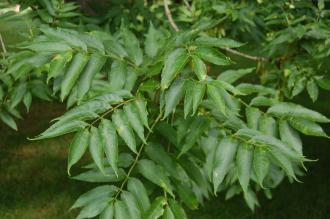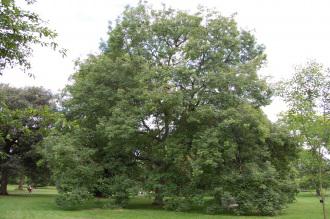
Fraxinus excelsior Leaf (28/07/2012, Kew Gardens, London)
Position: Full sun
Flowering period: Spring
Soil: Moist, well drained
Eventual Height: 40m
Eventual Spread: 25m
Hardiness: 4b – 9b
Family: Oleaceae
Fraxinus excelsior is a fast growing, large deciduous tree with a tall domed crown. Its mid green leaves are up to 35cm long, pinnate, compound, with up to 13 leaflets. Each leaflet is lanceolate with serrate margins, up to 12cm long and 3cm broad Its distinctive buds are black. Its trunk may achieve a diameter of up to 2m. Its bark is smooth on young trees becoming vertically fissured with age. Its dark purple hermaphrodite flowers do not have petals, appear in clusters and appear before the leaves. Its fruit is a sumara and up to 4.5cm long.

Fraxinus excelsior (28/07/2012, Kew Gardens, London)
Fraxinus excelsior, commonly known as Ash, European Ash or Common Ash, is native to most of Europe (including the UK, excluding the extreme north and south west), northern Turkey and the Caucasus. It is the fourth commonest tree species in the UK and may be the dominant species in a woodland. Ash die-back has affected a large number of threes in eastern and northern Europe, this is caused by the fungus Chalara fraxinea.
The etymological root of the binomial name Fraxinus is from the ancient Latin name for this tree. Excelsior is from the Latin meaning ‘ever upward’.

Fraxinus excelsior Bark (28/07/2012, Kew Gardens, London)
The landscape architect may find Fraxinus excelsior useful as part of a native woodland scheme. It is a tree that may be coppiced. It is tolerant of urban pollution.
Ecologically, F. excelsior is attractive to birds and mammals for its seed.
F. excelsior prefers moist, deep, fertile, well-drained soils. It tolerates most pH of soil. It is usually found on calcareous substrates.
Fraxinus excelsior requires little maintenance.

